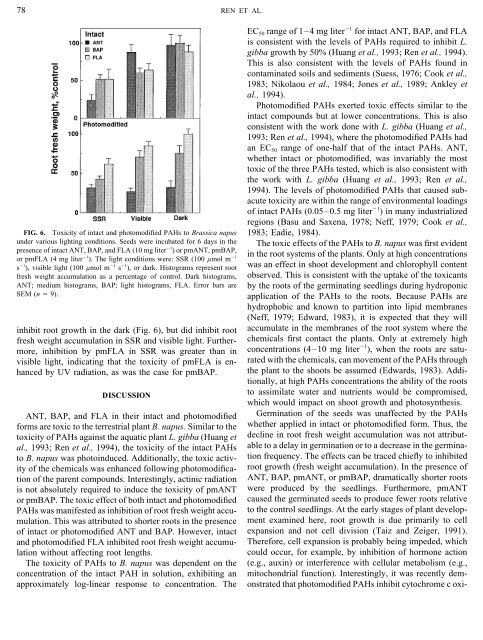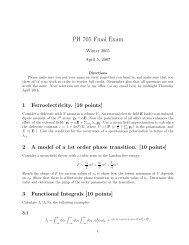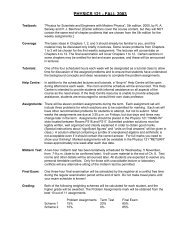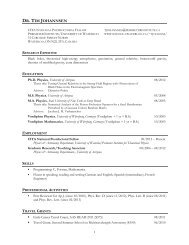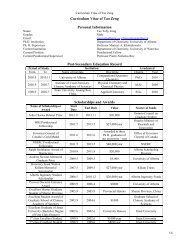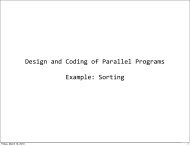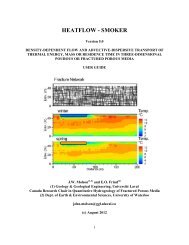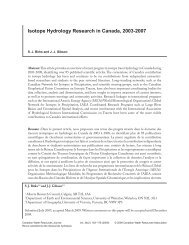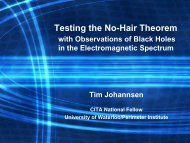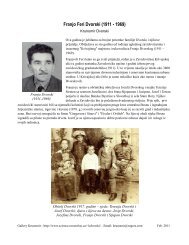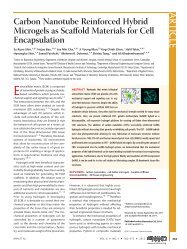45. Ren, L., Zeiler, L.F., Dixon, D.G. and Greenberg, B.M. 1996 ...
45. Ren, L., Zeiler, L.F., Dixon, D.G. and Greenberg, B.M. 1996 ...
45. Ren, L., Zeiler, L.F., Dixon, D.G. and Greenberg, B.M. 1996 ...
Create successful ePaper yourself
Turn your PDF publications into a flip-book with our unique Google optimized e-Paper software.
78 REN ET AL.<br />
EC 50 range of 1–4 mg liter 01 for intact ANT, BAP, <strong>and</strong> FLA<br />
is consistent with the levels of PAHs required to inhibit L.<br />
gibba growth by 50% (Huang et al., 1993; <strong>Ren</strong> et al., 1994).<br />
This is also consistent with the levels of PAHs found in<br />
contaminated soils <strong>and</strong> sediments (Suess, 1976; Cook et al.,<br />
1983; Nikolaou et al., 1984; Jones et al., 1989; Ankley et<br />
al., 1994).<br />
Photomodified PAHs exerted toxic effects similar to the<br />
intact compounds but at lower concentrations. This is also<br />
consistent with the work done with L. gibba (Huang et al.,<br />
1993; <strong>Ren</strong> et al., 1994), where the photomodified PAHs had<br />
an EC 50 range of one-half that of the intact PAHs. ANT,<br />
whether intact or photomodified, was invariably the most<br />
toxic of the three PAHs tested, which is also consistent with<br />
the work with L. gibba (Huang et al., 1993; <strong>Ren</strong> et al.,<br />
1994). The levels of photomodified PAHs that caused subacute<br />
toxicity are within the range of environmental loadings<br />
of intact PAHs (0.05–0.5 mg liter 01 ) in many industrialized<br />
regions (Basu <strong>and</strong> Saxena, 1978; Neff, 1979; Cook et al.,<br />
FIG. 6. Toxicity of intact <strong>and</strong> photomodified PAHs to Brassica napus 1983; Eadie, 1984).<br />
under various lighting conditions. Seeds were incubated for 6 days in the The toxic effects of the PAHs to B. napus was first evident<br />
presence of intact ANT, BAP, <strong>and</strong> FLA (10 mg liter 01 ) or pmANT, pmBAP,<br />
in the root systems of the plants. Only at high concentrations<br />
or pmFLA (4 mg liter 01 ). The light conditions were: SSR (100 mmol m 01<br />
s was an effect in shoot development <strong>and</strong> chlorophyll content<br />
), visible light (100 mmol m 01 s 01 ), or dark. Histograms represent root<br />
fresh weight accumulation as a percentage of control. Dark histograms, observed. This is consistent with the uptake of the toxicants<br />
ANT; medium histograms, BAP; light histograms, FLA. Error bars are by the roots of the germinating seedlings during hydroponic<br />
SEM (n Å 9).<br />
application of the PAHs to the roots. Because PAHs are<br />
hydrophobic <strong>and</strong> known to partition into lipid membranes<br />
(Neff, 1979; Edward, 1983), it is expected that they will<br />
inhibit root growth in the dark (Fig. 6), but did inhibit root accumulate in the membranes of the root system where the<br />
fresh weight accumulation in SSR <strong>and</strong> visible light. Furtherconcentrations<br />
chemicals first contact the plants. Only at extremely high<br />
more, inhibition by pmFLA in SSR was greater than in<br />
(4–10 mg liter 01 ), when the roots are satu-<br />
visible light, indicating that the toxicity of pmFLA is enthe<br />
rated with the chemicals, can movement of the PAHs through<br />
hanced by UV radiation, as was the case for pmBAP.<br />
plant to the shoots be assumed (Edwards, 1983). Addi-<br />
tionally, at high PAHs concentrations the ability of the roots<br />
DISCUSSION<br />
to assimilate water <strong>and</strong> nutrients would be compromised,<br />
which would impact on shoot growth <strong>and</strong> photosynthesis.<br />
ANT, BAP, <strong>and</strong> FLA in their intact <strong>and</strong> photomodified Germination of the seeds was unaffected by the PAHs<br />
forms are toxic to the terrestrial plant B. napus. Similar to the whether applied in intact or photomodified form. Thus, the<br />
toxicity of PAHs against the aquatic plant L. gibba (Huang et decline in root fresh weight accumulation was not attributal.,<br />
1993; <strong>Ren</strong> et al., 1994), the toxicity of the intact PAHs able to a delay in germination or to a decrease in the germina-<br />
to B. napus was photoinduced. Additionally, the toxic activroot<br />
growth (fresh weight accumulation). In the presence of<br />
tion frequency. The effects can be traced chiefly to inhibited<br />
ity of the chemicals was enhanced following photomodification<br />
of the parent compounds. Interestingly, actinic radiation ANT, BAP, pmANT, or pmBAP, dramatically shorter roots<br />
is not absolutely required to induce the toxicity of pmANT were produced by the seedlings. Furthermore, pmANT<br />
or pmBAP. The toxic effect of both intact <strong>and</strong> photomodified caused the germinated seeds to produce fewer roots relative<br />
PAHs was manifested as inhibition of root fresh weight accument<br />
to the control seedlings. At the early stages of plant developmulation.<br />
This was attributed to shorter roots in the presence<br />
examined here, root growth is due primarily to cell<br />
of intact or photomodified ANT <strong>and</strong> BAP. However, intact expansion <strong>and</strong> not cell division (Taiz <strong>and</strong> Zeiger, 1991).<br />
<strong>and</strong> photomodified FLA inhibited root fresh weight accumucould<br />
Therefore, cell expansion is probably being impeded, which<br />
lation without affecting root lengths.<br />
occur, for example, by inhibition of hormone<br />
action<br />
(e.g., auxin) or interference with cellular metabolism (e.g.,<br />
mitochondrial function). Interestingly, it was recently dem-<br />
onstrated that photomodified PAHs inhibit cytochrome c oxi-<br />
The toxicity of PAHs to B. napus was dependent on the<br />
concentration of the intact PAH in solution, exhibiting an<br />
approximately log-linear response to concentration. The


